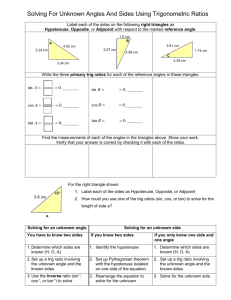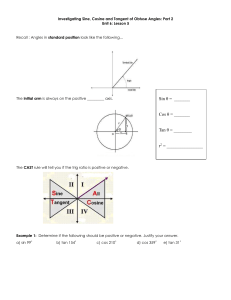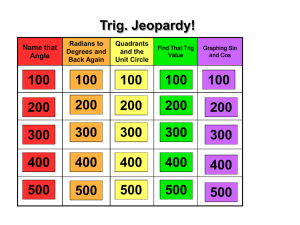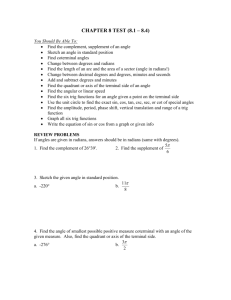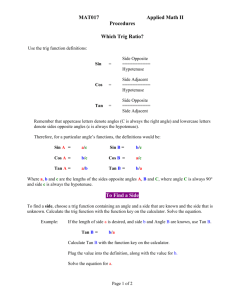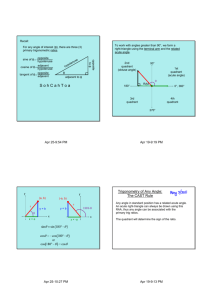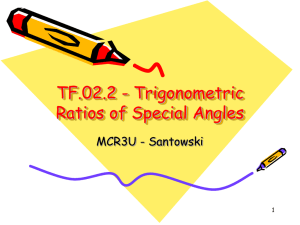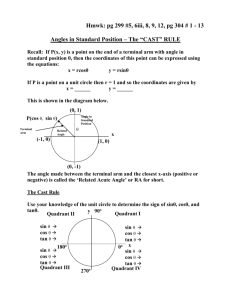here - I really love math.com
advertisement
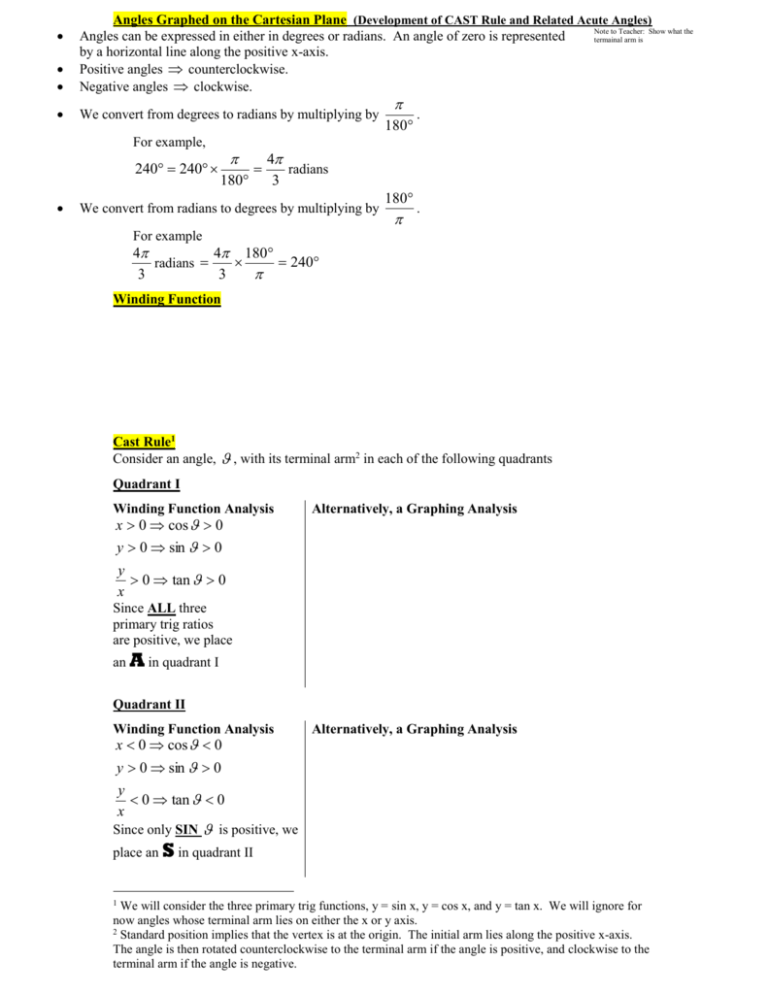
Angles Graphed on the Cartesian Plane (Development of CAST Rule and Related Acute Angles) Note to Teacher: Show what the Angles can be expressed in either in degrees or radians. An angle of zero is represented termainal arm is by a horizontal line along the positive x-axis. Positive angles counterclockwise. Negative angles clockwise. We convert from degrees to radians by multiplying by For example, 240 240 180 4 radians 3 We convert from radians to degrees by multiplying by 180 180 . . For example 4 4 180 240 radians 3 3 Winding Function Cast Rule1 Consider an angle, , with its terminal arm2 in each of the following quadrants Quadrant I Winding Function Analysis x 0 cos 0 Alternatively, a Graphing Analysis y 0 sin 0 y 0 tan 0 x Since ALL three primary trig ratios are positive, we place an A in quadrant I Quadrant II Winding Function Analysis x 0 cos 0 Alternatively, a Graphing Analysis y 0 sin 0 y 0 tan 0 x Since only SIN is positive, we place an S in quadrant II 1 We will consider the three primary trig functions, y = sin x, y = cos x, and y = tan x. We will ignore for now angles whose terminal arm lies on either the x or y axis. 2 Standard position implies that the vertex is at the origin. The initial arm lies along the positive x-axis. The angle is then rotated counterclockwise to the terminal arm if the angle is positive, and clockwise to the terminal arm if the angle is negative. Quadrant III Winding Function Analysis x 0 cos 0 Alternatively, a Graphing Analysis y 0 sin 0 y 0 tan 0 x Since only TAN is positive, we place a T in quadrant III Quadrant IV Winding Function Analysis x 0 cos 0 Alternatively, a Graphing Analysis y 0 sin 0 y 0 tan 0 x Since only COS is positive, we place a C in quadrant IV Summary of Cast Rule In summary, the CAST rule states that the primary trig ratios that are positive within3 each quadrant are given by this diagram, where A stands for all, and S, T, and C stand for their respective trig ratios. Related Acute Angles The related acute angle of (RAA of ) is the positive acute angle made by the terminal arm of with the x-axis. Examples: Determine the related acute angle of each of the following a) 160۫ b) 345۫ c) -191۫ 312۫ d) e) 35۫ f) Day 1 Relevance of Related Acute Angles Look at the graph of the curve y sin x . (There are vertical lines drawn at intervals of 90 to show where the quadrants are.) Let’s compare the angles 30 and 150 1. Both angles are in a positive sin quadrant according to the CAST Rule 2. RAA of 30 = 30 and RAA of 150 = 30 3. 3 sin 30 0.5 and sin 150 0.5 Again, we are ignoring for now angles whose terminal arm lies on either the x-axis or y-axis. 812۫ Let’s compare the angles 240 and 300 1. Both angles are in a negative sin quadrant according to the CAST Rule 2. RAA of 240 = 60 and RAA of 300 = 60 3. sin 240 3 2 and sin 300 3 2 These examples can be generalized to the other two primary trig ratios, and they show us how to approach the following questions. Example: Solve for x in each of the following examples. a) sin x 0.8111,0 x 360 Draw a Cartesian plane, with the CAST rule Rotate counterclockwise from the least angle in the domain to the greatest angle in the domain Identify each relevant quadrant with a terminal arm Evaluate the relevant related acute angle by using the winding function or in some cases an inverse trig function (for example the sin 1 , cos 1 , or tan 1 button on your calculator). This RAA will be the RAA of every valid answer to our original question. For each of the terminal arms that you drew at the third step, above, evaluate the angle in that quadrant with the relevant RAA. b) cos x 0.2346,0 x 720 c) tan x 2.1692,90 x 540 Day 2 2. Determine the principal angle of an angle, , in standard position such that cos .3333 and the terminal arm is in quadrant 3. Day 3 Determining Trig Ratios from Coordinates (i.e., Ordered Pairs) Consider a point ( x, y ) on the Cartesian plane. Imagine an angle such that the terminal arm of in standard position intersects the point ( x, y ) . From the Pythagorean theorem, we can evaluate the length, r, of the segment from the origin to the point (x, y). Specifically, r x 2 y 2 , meaning that r is always positive. From Grade 10, we learned the following y sin r x cos r y tan x Examples: a) Determine the angle , , 0 360 in standard position that has a terminal arm through the point (4, -5) b) Determine all angles , , 360 360 in standard position that have a terminal arm through the point (-2, -1) c) Evaluate tan to four decimal places, where is an angle in standard position with its terminal arm in the fourth quadrant and cos 0.5678 . Day 4 When the Terminal Arm of an Angle Lies on the x-axis or y-axis Simply refer back to the winding function, or look at the of the curve. Example: Solve for x,360 x 360 where sin x 0 Example: Solve for x,360 x 360 where cos x 1 Day 5 Solving Linear Trig Equations Solve each of the following for x 1. 3 sin x 1 2,0 x 360 Isolate the relevant trig ratio on one side of the equation Solve for the relevant variable 2. 2 tan x 4 5 tan x,0 x 360 3. 4 cos x 5 1,0 x 360 Day 6 Solving Quadratic Trig Equations Solve the following for x 1. 3 cos 2 x 5 cos x 2,0 x 360 Set one side of the equation equal to zero Factor in terms of the relevant trig ratio. It may be helpful to use the method of substitution. Solve for the relevant variable Day 7, 8 Examples involving Multiple Angles, etc Solve for x in each of the following questions a) sin 2x 0.1234 ,0 x 360 Draw a Cartesian plane, with the CAST rule Let w equal the angle given in the question. Restate the domain in terms of w. We’ll call this the substitute domain Rotate counterclockwise from the least angle in the substitute domain to the greatest angle in the substitute domain Solve for all values of w. Restate all of these solutions in terms of the relevant variable. b) tan 1 x 1.4 ,0 x 360 2 cos( x 90) 0.7777 ,0 x 360 c) Day 9, 10 Word Problems Involving Trig Graphs Perhaps the easiest way to answer a word problem is Determine the independent variable (x-axis) and the dependent variable (y-axis) Determine the minimum and maximum y-values, and the x-values at which these occur Graph these points on a Cartesian plane, then draw a couple cycles of a consistent sinusoidal curve involving them o This will give you the value for q and a. o If you prefer to use sin curves, look for a point where the curve intersects the axis of symmetry on the way up – the x-value at this point is p o If you prefer to use cos curves, look for a point where the curve achieves its maximum point – the x-value at this point is p 360 period 2 o If you prefer radians, k period o If you prefer degrees, k From the graph, determine the equation of the curve It is often advisable when working on a question to plot relevant points on the curve Examples: 1. A Ferris wheel has a radius of 20 metres. The lowest point on the wheel is 3 metres above the ground. One revolution of the wheel takes 4 minutes. Timmy is on the Ferris wheel, and when the ride starts he is at the lowest point of the wheel, with his date. a. Determine an equation representing Timmy’s height, h in metres, at any time, t in seconds, from the start of the ride. b. What is Timmy’s elevation after 1 minute and 30 seconds? c. Timmy’s lucky numbers are 37 and 4. He would like to put arm around his date the fourth time that their car is 37 metres above the ground. How much time will elapse from the start of the ride before he can try this? d. Will he have the courage to try it? 2. The tides at Massey beach are very regular. They come in and go out twice per day. The maximum water level is 40 metres, and this occurs at 8:00 a.m. The minimum water level is 6 metres, and this occurs at 2:00 a.m. a. Determine an equation representing the height, h in metres, of the water level at any time, t in minutes after midnight? b. How high will the water level be at 5:30 a.m.? c. At what times during the day will the water be 19 metres high (rounded to the nearest minute)? Day 11, 12, 13

